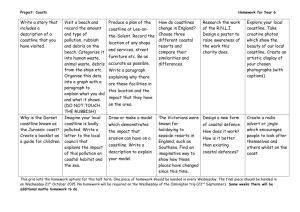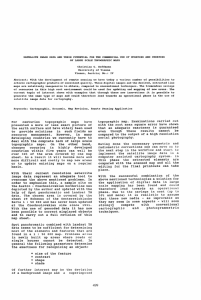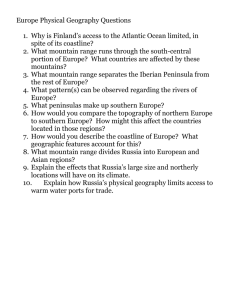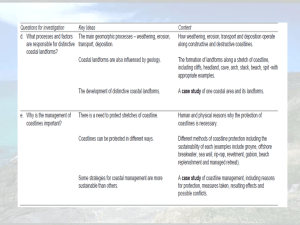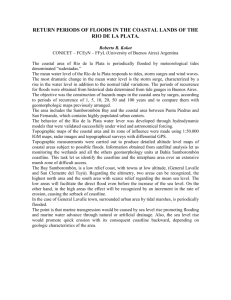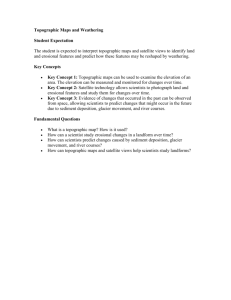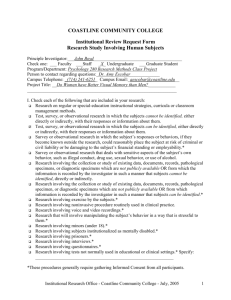Document 11841402
advertisement
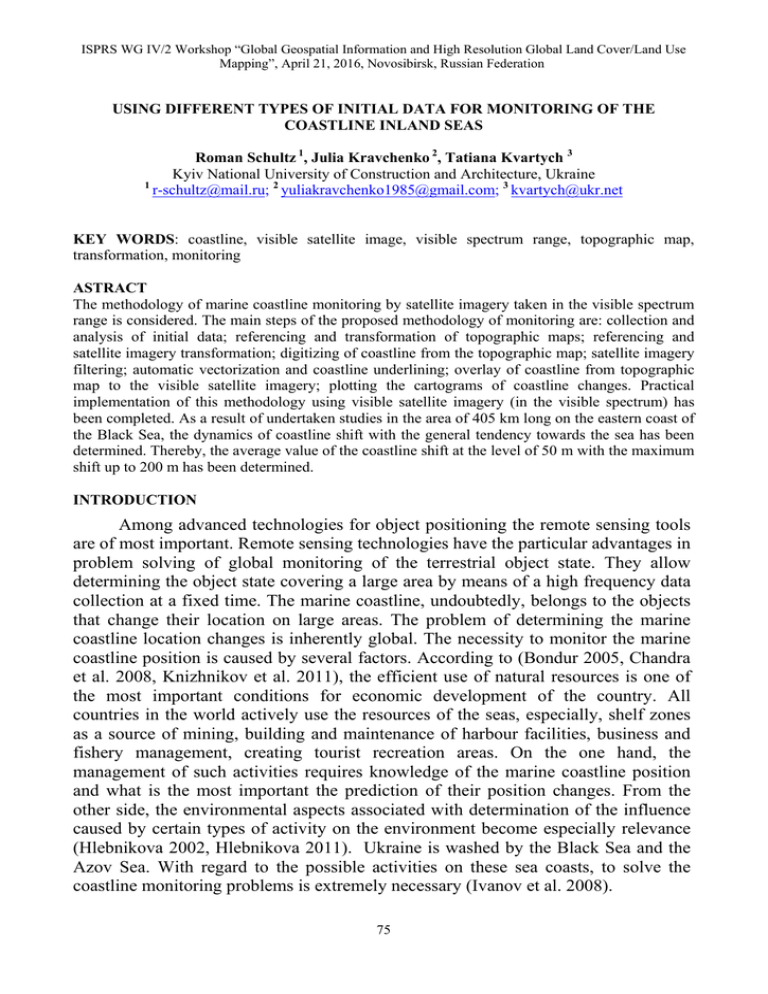
ISPRS WG IV/2 Workshop “Global Geospatial Information and High Resolution Global Land Cover/Land Use Mapping”, April 21, 2016, Novosibirsk, Russian Federation USING DIFFERENT TYPES OF INITIAL DATA FOR MONITORING OF THE COASTLINE INLAND SEAS Roman Schultz 1, Julia Kravchenko 2, Tatiana Kvartych 3 Kyiv National University of Construction and Architecture, Ukraine 1 r-schultz@mail.ru; 2 yuliakravchenko1985@gmail.com; 3 kvartych@ukr.net KEY WORDS: coastline, visible satellite image, visible spectrum range, topographic map, transformation, monitoring ASTRACT The methodology of marine coastline monitoring by satellite imagery taken in the visible spectrum range is considered. The main steps of the proposed methodology of monitoring are: collection and analysis of initial data; referencing and transformation of topographic maps; referencing and satellite imagery transformation; digitizing of coastline from the topographic map; satellite imagery filtering; automatic vectorization and coastline underlining; overlay of coastline from topographic map to the visible satellite imagery; plotting the cartograms of coastline changes. Practical implementation of this methodology using visible satellite imagery (in the visible spectrum) has been completed. As a result of undertaken studies in the area of 405 km long on the eastern coast of the Black Sea, the dynamics of coastline shift with the general tendency towards the sea has been determined. Thereby, the average value of the coastline shift at the level of 50 m with the maximum shift up to 200 m has been determined. INTRODUCTION Among advanced technologies for object positioning the remote sensing tools are of most important. Remote sensing technologies have the particular advantages in problem solving of global monitoring of the terrestrial object state. They allow determining the object state covering a large area by means of a high frequency data collection at a fixed time. The marine coastline, undoubtedly, belongs to the objects that change their location on large areas. The problem of determining the marine coastline location changes is inherently global. The necessity to monitor the marine coastline position is caused by several factors. According to (Bondur 2005, Chandra et al. 2008, Knizhnikov et al. 2011), the efficient use of natural resources is one of the most important conditions for economic development of the country. All countries in the world actively use the resources of the seas, especially, shelf zones as a source of mining, building and maintenance of harbour facilities, business and fishery management, creating tourist recreation areas. On the one hand, the management of such activities requires knowledge of the marine coastline position and what is the most important the prediction of their position changes. From the other side, the environmental aspects associated with determination of the influence caused by certain types of activity on the environment become especially relevance (Hlebnikova 2002, Hlebnikova 2011). Ukraine is washed by the Black Sea and the Azov Sea. With regard to the possible activities on these sea coasts, to solve the coastline monitoring problems is extremely necessary (Ivanov et al. 2008). 75 ISPRS WG IV/2 Workshop “Global Geospatial Information and High Resolution Global Land Cover/Land Use Mapping”, April 21, 2016, Novosibirsk, Russian Federation Development of methodology and technological schemes for the monitoring of the marine coastline position by integrated use of various types of satellite imagery is the topical problem. Its decision will give rise to the further development of other types of studies related to satellite environmental monitoring. INVESTIGATION AND RESULTS OF MONITORING Analysing the possibility of using remote sensing data for monitoring of marine coastline position, we should mention the requirements for the accuracy of problem solving. Actually, it corresponds to the accuracy of hydrographic survey. The accuracy of hydrographic survey is regulated by the decision of the International Hydrographic Organization (IHO) in Monaco and distributed by a Special Decree №44. IHO establishes several survey accuracy standards. According “IHO Standards for Hydrographic Surveys (S-44), 5th Edition, dated February 2008” the following classes were set: a special class of survey, that is a horizontal coastline position error with 95% confidence level equals to 10 m (such accuracy is required only for coastal areas with the engineering structures. In this case a coastline, as a rule, is regulated and fixed by traditional surveying methods on a regular basis); for classes 1a and 1b, class 2 a horizontal coastline position error with 95% confidence level equals to 20 m. Therefore, we may come to the conclusion that according to the international requirements a root-mean-square (RMS) error for marine coastline position is specified as equal to 10 m. In this case, it is recommended to use for the purposes of monitoring the following data: - Topographic maps at scale 1: 50 000 (RMS = 0.2 m = 10 m) - Visible satellite imagery with 30 – 10 m resolution (the object width occupies 0,5 pixel); - Satellite radar imagery with 30 – 10 m resolution of (the object width occupies 0.5 pixel) (Fleming, 2005). The analysis allowed us to develop and offer the general technological scheme. At the first stage the coastline position is determined using topographic maps at scales 1:50 000 – 1:100 000. The coastline obtained is the basis according to which future position changes are determined. The current coastline position is determined by the visible satellite imagery. The next step is to compare the border of water / land obtained from a topographic map and satellite images. The result of this comparison is the cartogram of a coastline shift by which we may determine the value and the rate of coastline position change. Geoinformation analysis is carried out for solving the problem of further coastline position change prediction. This approach allows us to reveal the reasons of coastline position changes as well as to predict the future changes. Taking into consideration mentioned above, the methodology of monitoring marine coastline by visible satellite imagery is offered. The technological scheme of methodology is given in Figure 1. 76 ISPRS WG IV/2 Workshop “Global Geospatial Information and High Resolution Global Land Cover/Land Use Mapping”, April 21, 2016, Novosibirsk, Russian Federation Initial data collection and analysis Visible Satellite imagery Topographic map Referencing and transforming of topographic maps Satellite image filtering Automatic vectorization and coastline underlining Digitizing of coastline from the topographic map Referencing and satellite imagery transformation Overlay of coastline from the topographic map to the visible satellite imagery Plotting cartograms of coastline changes Overlay cartograms of coastline changes with a geological map, soil map and etc. at the GIS for prediction of the future coastline changes Figure 1: The technological scheme of methodology for monitoring of coastline changes Now the proposed methodology is considered in detail. The methodology includes the following stages: 1. Initial data acquisition and analysis. The monitoring process is planned at this stage and includes the correct selection of satellite imagery of the appropriate area, determination of the water level, correct registration of tides and meteorological factors. 2. Referencing and transforming of topographic maps. The coastline obtained from topographic maps serves as a source of the initial data, which can be used for comparison of further obtained results. Therefore, it is important to make a correct referencing of topographic map in the chosen coordinate system. For these purposes it is necessary to take into account the two factors. The first one 77 ISPRS WG IV/2 Workshop “Global Geospatial Information and High Resolution Global Land Cover/Land Use Mapping”, April 21, 2016, Novosibirsk, Russian Federation is to choose the coordinate system. Since the imagery is obtained in WGS-84 / UTM, then either the images are projected into the coordinate system of the topographic map or there is a necessity to refer the topographic maps and their further projecting to WGS-84/UTM. The second factor concerns the initial topographic maps having significant deformations. That is why the models of topographic map deformations should be chosen in the right way. 3. Referencing and satellite imagery transformation. In contrast with the ultrahigh resolution imagery the high resolution satellite imagery is often available with the binding file. If the binding file is unavailable, the imagery should be referred to the larger scale topographic map having regard to the special aspects described at the stage 2. 4. Digitizing of coastline from the topographic map. It is performed after referencing in any GIS. 5. Filtering of satellite image. Due to objective reasons satellite images have radiometric errors or distortions (Hong 2007, Shovengerdt 2010). When carrying out automatic digitization of objects from the imagery, such distortions can significantly distort the vectorization results. To eliminate these distortions, the imagery should be filtered. 6. Automatic vectorization and coastline underlining. There are several algorithms for contour extraction on photographic images (Hong 2007, Ris 2006, Shovengerdt 2010). After contour extraction the automatic vectorization of them is performed. 7. Coastline overlay from the topographic map to the visible satellite imagery. At this stage any of the known GIS is used (Gomarasca 2004). 8. Plotting the cartograms of coastline changes. After coastline overlay from the topographic map and the satellite imagery we obtained areas which point to the coastline position changes. These areas are generated either automatically or by direct measurements. 9. Overlay the cartogram of coastline changes on the geological map, soil map, etc. in the GIS to predict the further coastline changes. The purpose of this final stage is to reveal the possible reasons of coastline changes as well as to generate the mathematical models for prediction of further changes. According to above considered stages, first of all it is necessary to analyse the mathematical models of transformation of initial cartographic data (topographic maps) with the purpose to select the transformation models, which on the one side, provides the necessary accuracy of referencing, and on the other side, does not lead to the initial cartographic data deformation. Modern monitoring tools include the use of information only in digital form (Konecny 2003). In such a case the topographic maps should be scanned and referred to the required coordinate system. Therefore, we have to choose a corresponding mathematical model for topographic map transformation, which will be able to take into account the possible deformations of cartographic originals caused by the map aging and scanning errors. 78 ISPRS WG IV/2 Workshop “Global Geospatial Information and High Resolution Global Land Cover/Land Use Mapping”, April 21, 2016, Novosibirsk, Russian Federation We have taken the well-known mathematical models for transformation of raster images in our investigations. For any type of transformation we use the redundant measurements to carry out the accuracy estimation of obtaining coefficients by least squares estimation with subsequent assessment of transformation accuracy. The easiest type of transformation is a linear and it is applied for the shift. For the calculation of transformation parameters, we should have at least one point. This transformation in analytical form is as follows: x =+ x0 xˆ; y =+ y0 yˆ (1) Where: x, y - the point coordinates in the new coordinate system, xˆ , yˆ - the point coordinates in the old coordinate system; x0 , y0 - shifts of the one coordinate system relative to the other. Another, more complex type of linear transformation is a shift-rotation. For the calculation of transformation parameters, we should have at least two points. This transformation in the analytical form is written as: x= x0 + xˆ cos α − yˆ sin α; y = y0 + yˆ cos α + xˆ sin α (2) Where: α - rotation angle of one coordinate system relative to another. Among the models discussed above the most advanced transformation is the shift-rotation-scaling. For the surveyors this transformation is known as the Helmert transformation. We should have at least two points for the calculation of transformation parameters. This transformation in the analytical form is presented in terms of the following formula: x= x0 + m ( xˆ cos α − yˆ sin α ) ; y = y0 + m ( yˆ cos α + xˆ sin α ) (3) Where: m - a scale coefficient. The latest model of linear transformation, which we analyse, is an affine transformation. For the calculation of transformation parameters, we should have at least three points. This transformation in the analytical form may be written as: x =a0 + a1 xˆ + a2 yˆ ; y =b0 + b2 yˆ + b1 xˆ (4) Where: ai , bi - affine transformation coefficients. Among the well-known nonlinear transformation models we took for the analysis a polynomial transformation. For the calculation of transformation parameters, we should have the number of points equal to the number of the polynomial coefficients. The transformation in the analytical form can be written by the following formula: n n −i n n −i =i 0=j 0 =i 0=j 0 i j i j = x ∑ = ∑ aij xˆ yˆ ; y ∑ ∑ bij xˆ yˆ (5) Where: n – a polynomial degree. Topographic maps covering the territory of the Black Sea coast at scale 1: 50 000 in SC-42 coordinate system were used for our investigations. The total number of 79 ISPRS WG IV/2 Workshop “Global Geospatial Information and High Resolution Global Land Cover/Land Use Mapping”, April 21, 2016, Novosibirsk, Russian Federation raster images is 139. In this case for identification of deformation behaviour and choose of the required transformation model has been suggested that the deformation behaviour is related to the date of topographic map creation and production. Therefore, all raster images have been divided into approximately uniform four groups: maps issued before 1975, before 1980, before 1985, and before 1990. The coordinates of 25 grid reference were measured using each raster image. The results of the measurements made possible to calculate the transformation parameters for different raster groups and transformation models. The averaged values for the transformation parameters are given in Table. 1 Table 1. The results of raster transformation Year of map production Type of transformation Number of points 1975 1980 1985 1990 mx/my, m mx/my, m mx/my, m mx/my, m Helmert Affine Polynomial n=2 Polynomial n=3 Polynomial n=4 9 15,2 15,4 5,6 6,7 15,5 15,2 7,5 9,4 13 14,0 14,0 5,4 7,5 15,2 14,7 6,6 8,5 25 14,4 15,1 6,7 7,3 16,7 15,5 7,2 8,5 9 7,1 5,5 4,0 5,3 4,6 3,2 3,5 7,0 13 7,6 6,3 3,5 6,3 4,6 5,4 4,0 7,0 25 6,7 6,4 3,6 5,6 5,0 4,8 5,0 7,0 9 3,3 1,6 3,3 4,3 2,2 2,6 2,6 4,8 13 5,0 3,2 3,1 5,6 2,9 4,5 3,7 6,6 25 4,1 4 3,1 5,5 4,3 4,1 4,6 6,3 13 1,5 2,2 1,3 2,7 2,2 2,6 1,9 1,7 25 2,2 3,7 2,0 4,1 2,8 2,6 3,0 3,4 25 1,5 2,8 1,4 2,4 1,6 1,6 2,0 2,5 Analysing the data from Table 1, we can make a conclusion that there is a relationship between the deformation behaviour and the date of topographic map production. Comparing the transformation results using linear and polynomial models, we make a conclusion that the rasters under study have nonlinear distortions. In spite of the fact that 3d and 4th order polynomials provide a high accuracy for transformation of raster images, we ought to bear in mind that high-degree polynomials lead to undesirable distortions in the raster coordinates, and even a distortion of the original image. 80 ISPRS WG IV/2 Workshop “Global Geospatial Information and High Resolution Global Land Cover/Land Use Mapping”, April 21, 2016, Novosibirsk, Russian Federation According to the Guidelines for topographic map creation we have defined the required accuracy that the RMS error of point position on the map should not exceed: m p ≤ 0, 2 M Where: M - a scale denominator. For topographical maps scale 1: 50 000 the RMS error of measuring contour point position is 10 m. Hereby, in order to exclude the influence of the residual transformation error on the accuracy of further measurements, it is sufficient that the RMS of transformation is not exceeding the follows: 0,07 M mt ≤ 1 m p = 3 or per each of the coordinate axes: mt X ≤ 0, 05M ; mtY ≤ 0, 05M . (6) If analyse Table 1 taking into account the criterion (6), it becomes evident that the model transformation using 2nd order polynomials or 3rd order polynomials with the number of points up to 13 satisfies the criteria in the best way. Increasing the number of points leads to the occurrence of the non-linearity effect and original raster distortions. If residual deviations are negligible, it is sufficient to use the affine transformation. If local deformations are significant and cannot be removed by the earlier mentioned transformation methods, then it is advisable to use the method of “sheet rubber”. According to the technological scheme given in Figure 1, all the main stages for monitoring of marine coastline position were investigated. Now we pass on to the overlaying the coastline from the topographic map to the visible satellite imagery. We have used for monitoring the following initial data: • LANDSAT-7 satellite imagery (panchromatic) with a resolution 15 m covering the western and the eastern coast of the Black Sea in WGS-84, UTM 35, Zone 36. • OrbWiev-3 satellite imagery (panchromatic) with a resolution 1 m covering the western and the eastern coast of the Black Sea in WGS-84, projection UTM 35, Zone 36. • A digital elevation model covering the entire coastline of the Black Sea obtained as a result of ASTER satellite imagery processing with the declared horizontal accuracy of 8 m in WGS-84, projection UTM 35, Zone 36. • Topographic maps at scale 1:50 000 covering the eastern coast of the Black Sea. Data processing has performed with the following parameters: 1. Referencing of satellite imagery was made using MapInfo 11.5 software, WGS-84, UTM 35, Zone 36. 2. Referencing of topography maps was made using MapInfo 11.5 software, CS-42 coordinate system, Gauss-Kruger projection, Zone 5 with a further projection into WGS-84, UTM 35, Zone 36. 81 ISPRS WG IV/2 Workshop “Global Geospatial Information and High Resolution Global Land Cover/Land Use Mapping”, April 21, 2016, Novosibirsk, Russian Federation 3. Satellite imagery filtering was made using ScanEx IMAGE Processor v.3.6.9 software package and ERDAS 9.1 and by means of a median filter. Smoothing was made after filtration by Hermite splines. 4. Automated coastline underlining on the satellite image was made by ScanEx IMAGE Processor v.3.6.9 and ERDAS 9.1 software package 5. Automatic coastline vectorization was made by EasyTrace ERDAS 9.1 software. The main results obtained at stages 1-5 are given below. Figure 2: Vector map fragment of the eastern Black Sea coast Figure 3: Digitizing marine coastline of the eastern Black Sea coast from raster topographic maps 82 ISPRS WG IV/2 Workshop “Global Geospatial Information and High Resolution Global Land Cover/Land Use Mapping”, April 21, 2016, Novosibirsk, Russian Federation The marine coastline was obtained from the topographic vector and raster maps. It characterizes the marine coastline position for 1975-1990. In order to get the actual position of the coastline LANDSAT-7 satellite imagery (2005) was used. The positional checking was done by OrbWiev-3 satellite imagery and a digital elevation model generated using ASTER satellite imagery. Figure 4: Digitalization of the eastern Black Sea coast from LANDSAT-7 satellite imagery Overlapping of two coastlines from topographic maps and satellite imagery was made after digitizing the marine coastline. Figure 5: A fragment of overlapping the two eastern Black Sea coastlines Drawing coastline was checked in some disputed point using ASTER digital elevation model, the accuracy of which permits to apply it as a reference one, and its quality is confirmed by a lot of studies. 83 ISPRS WG IV/2 Workshop “Global Geospatial Information and High Resolution Global Land Cover/Land Use Mapping”, April 21, 2016, Novosibirsk, Russian Federation As a result of undertaken studies in the area of 405 km long on the eastern Black Sea coast, the marine coastline shift dynamics with the general tendency towards the sea has been determined. Thereby, the average value of the coastline shift at the level of 50 m with the maximum shift up to 200 m has been determined. Control measurements on OrbWiev-3 satellite imagery with 1-m spatial resolution confirmed these results. CONCLUSION The methodology of marine coastline monitoring on satellite imagery in the visible spectrum range has been developed as a result of our studies. The general stages of the proposed monitoring methodology are as follows: initial data acquisition and analysis; referencing and transforming of topographic maps; referencing and satellite image transformation; digitizing of a coastline from the topographic map; filtering of satellite images; automatic vectorization and coastline underlining; overlay of coastline from topographic map to the visible satellite imagery; plotting the cartograms of coastline changes. This methodology allows modelling of predicted future coastline and revealing the possible reasons of coastline changes based on overlap cartograms of coastline changes with the geological map, soil map, etc. in the GIS. The developed methodology for marine coastline monitoring by satellite imagery in the visible spectrum range has been implemented in practice. As a result of undertaken studies in the area of 405 km long on the eastern Black Sea coast, the dynamics of marine coastline shift with the general tendency towards the sea has been determined. Thereby, the average value of the coastline shift at the level of 50 m with the maximum shift up to 200 m has been determined. Control measurements on OrbWiev-3 satellite imagery with 1-m spatial resolution confirmed these results. REFERENCES BONDUR V.: The complex space monitoring of coastal waters. Moscow, Scientific Center of Aerospace Monitoring Problems, "Aerocosmos", 2005, 12 p. CHANDRA A., GHOSH S.: Remote sensing and geographic information systems: Textbook. Moscow, Technosphere, 2008, 312 p. FLEMING, J.N.: Design of a Semi-Automatic Algorithm for Shoreline Extraction using Synthetic Aperture Radar (SAR) Images. M.Sc.E. thesis, Department of Geodesy and Geomatics Engineering Technical Report No. 231, Fredericton, New Brunswick (Canada): University of New Brunswick, 2005,149 p. GOMARASCA, A.M.: Basics of Geoinformatics. London, Springer, 2004, 690 p. HLEBNIKOVA E.: Features of recognition for monitoring of water objects. Herald SSGA, Novosibirsk, 2002, №7, Pp 101-107. HLEBNIKOVA E.: Pre-processing of multispectral satellite imagery to improve the state of 84 ISPRS WG IV/2 Workshop “Global Geospatial Information and High Resolution Global Land Cover/Land Use Mapping”, April 21, 2016, Novosibirsk, Russian Federation water quality object recognition. Herald SSGA, Novosibirsk, 2011, №11, Pp 325-329. HONG, G. Image Fusion, Image Registration, and Radiometric Normalization for High Resolution Image Processing. Ph.D. thesis, Department of Geodesy and Geomatics Engineering Technical Report No. 247, Fredericton, New Brunswick (Canada): University of New Brunswick, 2007, 198 p. IVANOV V., MINKOVSKAYA R.: Marine estuary Ukrainian rivers and estuarine processes. Textbook in 2 parts, National Academy of Sciences of Ukraine, Marine hydrophysical institute, Sevastopol, 2008, 806 p. KNIZHNIKOV Y., KRAVTSOVA V, OV TUTUBALINA O.: Aerospace methods of geographical research. Moscow, Publishing Center "Academy", 2011, 416 p. KONECNY, G. Geoinformation. Remote Sensing, Photogrammetry and Geographic Information System, New York and London, Taylor & Francis, 2003, 266 p. RIS U.: Fundamentals of Remote Sensing. Moscow, Technosphere, 2006, 336 p. SHOVENGERDT R: Remote sensing. Models and methods for image processing: Textbook. Moscow, Technosphere, 2010, 560 p. Contact Prof. Dr. Roman Schultz Dean of the Faculty of GIS and Land Management Kyiv National University of Construction and Architecture 31, Povitroflotskyi Ave. Kiev 03038, Ukraine Tel.: +38 (044) 243-26-71 E-mail: r-schultz@mail.ru Assoc. Prof. Julia Kravchenko, PhD Department of Geoinformatics and Photogrammetry Kyiv National University of Construction and Architecture 31, Povitroflotskyi Ave. Kiev 03038, Ukraine Tel.: +38 (044) 241-55-69 E-mail: yuliakravchenko1985@gmail.com Tatiana Kvartych Department of Geoinformatics and Photogrammetry Kyiv National University of Construction and Architecture 31, Povitroflotskyi Ave. Kiev 03038, Ukraine Tel.: +38 (044) 241-55-67 E-mail: kvartych@ukr.net 85
